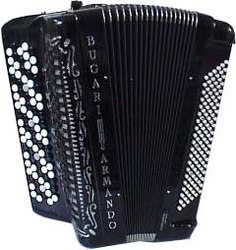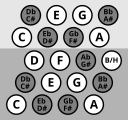Chromatic button accordion
 | |
| Classification | Free-reed aerophone |
|---|---|
| Playing range | |
|
Right-hand manual: The Russian bayan and chromatic button accordions have a much greater right-hand range in scientific pitch notation than an accordion with a piano keyboard: five octaves plus a minor third (written range = E2-G7, actual range = E1-C♯8).[1] Left-hand manual | |
| Musicians | |
| List of accordionists | |
| More articles or information | |
| Accordion, Chromatic button accordion, Bayan, Diatonic button accordion, Piano accordion, Stradella bass system, Free-bass system, Accordion reed ranks & switches | |
A chromatic button accordion is a type of button accordion where the melody-side keyboard consists of rows of buttons arranged chromatically. The bass-side keyboard is usually the Stradella system or one of the various free-bass systems. Included among chromatic button accordions are the Russian bayan and Schrammel accordion. There can be 3 to 5 rows of vertical treble buttons. In a 5 row chromatic, two additional rows repeat the first 2 rows to facilitate options in fingering.


Comparing the layout to the piano accordion,[2] the advantages of a chromatic button accordion are the greater range and better fingering options.[notes 1] On the other hand, some fingering positions require twisting of the wrist and the aspect of alternative fingering patterns may stunt one in sessions of difficult sight reading.[2]
Throughout the former Yugoslavia a 6-row chromatic button layout is used based on the B system. It is referred to as dugmetara.
Notes
- ^ The uniform layout allows for uniform fingering and making of chords; meanwhile, the chromatic button layout also allows for alternative fingerings. As the buttons are closer, it is also easier to reach notes that are far apart, such as two octaves apart.
References
- ^ Ricardo Llanos and Inaki Alberdi, "Accordion for Composers" (Spanish publication: 2002), 2-5).
- ^ a b Dan Lindgren, Piano Accordion vs. Chromatic Button Accordion Online PDF
